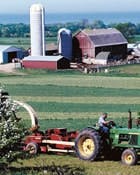The Environmental Law and Policy Center and the Mississippi River Collaborative are releasing “Cultivating Clean Water,” a new report that examines the effectiveness of state-based regulatory programs to control agricultural water pollution and recommends policies that will result in cleaner water.
This report provides a snapshot of what is currently a fragmented and poorly-implemented system of state-based regulation of agricultural pollution, the groups said. But the story is not one of failure, rather it is a story of unrealized potential.
Manure, fertilizer and other agricultural pollutants are a significant source of pollution affecting a huge number of lakes and streams across the country, endangering drinking water supplies, threatening wildlife and contributing to the massive Dead Zone in the Gulf of Mexico. The 1987 amendments to the federal Clean Water Act directed states to develop programs to control “non-point” sources of pollution such as agricultural runoff.
“However, current approaches are not delivering measurable improvements in water quality,” said Chris Jones of the Des Moines Water Works. “We continue to see elevated nitrate levels in the Raccoon and Des Moines Rivers that provide our source water, and some problems appear to be getting worse. These include the frequency and duration of harmful algae and cyanobacteria blooms, and ammonia loads delivered during the spring runoff.”
Voluntary agricultural conservation programs can play an important role in reducing water pollution if they are better targeted and fully funded.
“It is clear that voluntary programs alone will not get the job done and funding for voluntary programs continues to fall under the budget knife,” said Craig Cox of the Environmental Working Group. “We hope this report starts a serious conversation about regulatory approaches that work for agriculture and clean water.”
The report focuses on management practices to control nitrogen and phosphorus pollution because these two pollutants are cited by the U.S. Environmental Protection Agency (EPA) as two of the most significant pollutants impairing US rivers and lakes. According to a 2006 EPA report on wadeable streams, high levels of nitrogen and phosphorus pollution were found in nearly one-third of all streams studied.
“Cultivating Clean Water” provides an overview of existing state programs and gives a template for creating effective regulations that work well for farmers and the environment.
Part 1 of the report examines seven existing state regulatory programs that address agricultural non-point source pollution. These programs involve the statewide implementation of a pollution management plan and/or best management practices that minimize farm pollution of surface water and groundwater.
Part 2 of the report focuses on five common-sense agricultural management practices that are required by several states: vegetative buffers between crop land and water bodies, setbacks for applying manure and fertilizer near waterways, restrictions on applying manure in winter, keeping livestock out of water bodies and restrictions on applying fertilizer in fall.
Source: Environmental Law & Policy Center


